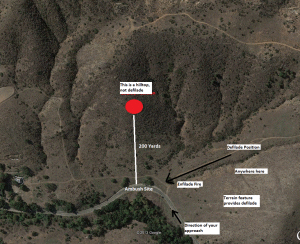What is Enfilade & Defilade?
I often see confusion out there when people reference both enfilade and defilade. It’s almost like people just throw out the term defilade. So, let’s define them:
ENFILADE: this is where you engage the enemy formation from the flank. You generate enfilade fire, which strikes the enemy from the flank. If we look at older generations of warfare, perhaps the trench warfare of WWI, we can see two examples:
1) If engaging a linear trench system, you have it in enfilade if your machine-gun can fire into the trench along the length of it. This is why trenches were dug in zig-zigs.
2) If the enemy gets out of their trenches, and assaults in an extended line towards your trenches, with your machine-gun to a flank, you can shoot along the line of advancing enemy. If you think about it, rounds will pass along the length of the enemy line, rather than through it directly from the front, creating a better chance of hitting the enemy. You will also have to traverse the gun less to encompass the enemy formation.
As an former anti-armor officer, the aim was the generate enfilade fire with anti-armor weapons, from a defilade position (more to follow on defilade). Creating defilade was one reason for the enfilade fire, but the other was that armor is weaker to the sides and rear of armored vehicles so side shots (enfilade) were better than front shots.
DEFILADE:
DOD/NATO Definition:
1. Protection from hostile observation and fire provided by an obstacle such as a hill, ridge, or bank. 2. A vertical distance by which a position is concealed from enemy observation. 3. To shield from enemy fire or observation by using natural or artificial obstacles.
Anti-Armor definition (BritMil):
A position in which you can only be engaged by enemy direct fire, or observed indirect fire, when they are in your killing area.
The practical employment of defilade can be achieved with a large piece of ground, such as a draw, or simply something like a berm or ditch. What it means is that you are not engaging enemy to your front, you are engaging them to your flank using enfilade fire. You protect your front with hard cover. If you use defilade in the context of a defensive position, then the ground to your front will be covered by mutually supporting positions firing from defilade. You fire across their front, they fire across yours. Sneaky.
If you employ defilade in an anti-armor role, such as an anti-armor ambush or defense, then what you will do is identify the enemy approach(es). Let’s assume that the enemy armored column is rolling down a valley. You will site your anti-armor weapons, plus machine-guns for the dismounts, dug-in in draws off the the side of the valley. Thus, as the enemy approaches, they cannot see your positions. They cannot engage them with direct fire, nor observe them to bring indirect fire down upon them. Because these are tanks right, and if they see you they will roll you up. Once the enemy rolls down the main valley into sight of your positions in the side draws, you are viewing them from the side, in enfilade. When your anti-tank missiles streak down, they will hit the enemy in the flank and even rear. Now, the enemy is in your killing area, and they can turn and engage you with direct fire, or observed indirect fire, but by now you are killing them , because it’s an ambush.
As an airborne anti-armor platoon commander, we viewed this role as being a ‘speed bump’ to an advancing enemy armored formation ![]()
To put this concept in simple terms, you decide that you are going to take out the school bully, because he stole your lunch money. He’s big, so you have to make it work. On his way home from school, you wait in an alley with a baseball bat. He comes walking along the sidewalk. He cannot see you, and engage you, until he walks out in front of the alleyway entrance. You are using the corner of the alleyway, the wall, as your defilade. As soon as he comes into view, you are going to hit him with an enfilade bat strike. You better get it right, or he will be on you!
In terms of the hasty attack planning exercise the enemy is not using defilade, because they are on top of the hill. I will attackh a diagram showing how they could use defilade.
Defilade can be used at a macro or micro-cover level. If you as a rifleman put a bank to your right, expecting the enemy to come from the right, and then engage them from the flank when they are in front of you, then you are firing in enfilade from a defilade position. You can fire in enfilade not from a defilade position, but then you are much more vulnerable. If you ambush the enemy from the side of the trail, and don’t have cover providing defilade, then you are vulnerable to fire from all of the enemy on the trail, as soon as they locate you.
In this movie clip (Stalingard) the Germans initially have an enfilade shoot, but it is lost when the Russian tanks turn towards them. The German position does not have defilade (just those scrappy trees on the left side). Imagine if there was a lump of ground on the left, meaning that the Russians emerged into view as they moved from left to right. That would be defilade, in this case. It would also mean that the German position would not have been seen, until later, or when they opened fire.
(The tank spinning on the foxhole was to collapse it. If an armored vehicle spins on an un-revetted (un-reinforced) trench it will collapses it in on the occupants. As part of anti-armor school we had tanks drive over the top of us to experience it. We also had to stand in the street, and they would drive a tank at us, and we had to touch the front, then lay down and let it go over the top. Cool).
Live Hard.
Die Free.
Max


